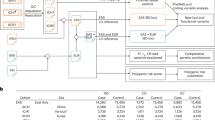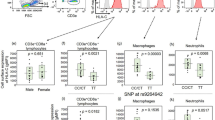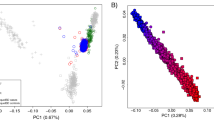Abstract
Ulcerative colitis is one of the principal forms of inflammatory bowel disease with complex manifestations. Although previous studies have indicated that there is a genetic contribution to the pathogenesis of ulcerative colitis, the genes influencing susceptibility to the disease have not been fully determined. To identify genetic factors conferring risk of ulcerative colitis, here we conducted a two-stage genome-wide association study and subsequent replication study using 1,384 Japanese individuals with ulcerative colitis and 3,057 control subjects. In addition to the expected strong association with the major histocompatibility complex (MHC) region, we identified three new susceptibility loci: the immunoglobulin receptor gene FCGR2A (rs1801274, P = 1.56 × 10−12), a locus on chromosome 13q12 (rs17085007, P = 6.64 × 10−8) and the glycoprotein gene SLC26A3 (rs2108225, P = 9.50 × 10−8). rs1801274 is a nonsynonymous SNP of FCGR2A that is reported to have a critical effect on receptor binding affinity for IgG and to be associated with other autoimmune diseases. Our findings provide insight into the molecular pathogenesis of ulcerative colitis.
This is a preview of subscription content, access via your institution
Access options
Subscribe to this journal
Receive 12 print issues and online access
$209.00 per year
only $17.42 per issue
Buy this article
- Purchase on Springer Link
- Instant access to full article PDF
Prices may be subject to local taxes which are calculated during checkout



Similar content being viewed by others
References
Podolsky, D.K. Inflammatory bowel disease. N. Engl. J. Med. 347, 417–429 (2002).
Loftus, E.V. Jr. Clinical epidemiology of inflammatory bowel disease: Incidence, prevalence, and environmental influences. Gastroenterology 126, 1504–1517 (2004).
Halme, L. et al. Family and twin studies in inflammatory bowel disease. World J. Gastroenterol. 12, 3668–3672 (2006).
Yamazaki, K. et al. Single nucleotide polymorphisms in TNFSF15 confer susceptibility to Crohn's disease. Hum. Mol. Genet. 14, 3499–3506 (2005).
Duerr, R.H. et al. A genome-wide association study identifies IL23R as an inflammatory bowel disease gene. Science 314, 1461–1463 (2006).
Hampe, J. et al. A genome-wide association scan of nonsynonymous SNPs identifies a susceptibility variant for Crohn disease in ATG16L1. Nat. Genet. 39, 207–211 (2007).
Barrett, J.C. et al. Genome-wide association defines more than 30 distinct susceptibility loci for Crohn's disease. Nat. Genet. 40, 955–962 (2008).
The Wellcome Trust Case Control Consortium. Genome-wide association study of 14,000 cases of seven common diseases and 3,000 shared controls. Nature 447, 661–678 (2007).
Franke, A. et al. Sequence variants in IL10, ARPC2 and multiple other loci contribute to ulcerative colitis susceptibility. Nat. Genet. 40, 1319–1323 (2008).
Silverberg, M.S. et al. Ulcerative colitis-risk loci on chromosomes 1p36 and 12q15 found by genome-wide association study. Nat. Genet. 41, 216–220 (2009).
Franke, A. et al. Replication of signals from recent studies of Crohn's disease identifies previously unknown disease loci for ulcerative colitis. Nat. Genet. 40, 713–715 (2008).
Anderson, C.A. et al. Investigation of Crohn's disease risk loci in ulcerative colitis further defines their molecular relationship. Gastroenterology 136, 523–529 (2009).
Yamazaki, K. et al. Absence of mutation in the NOD2/CARD15 gene among 483 Japanese patients with Crohn's disease. J. Hum. Genet. 47, 469–472 (2002).
Yamazaki, K. et al. Association analysis of genetic variants in IL23R, ATG16L1 and 5p13.1 loci with Crohn's disease in Japanese patients. J. Hum. Genet. 52, 575–583 (2007).
Yamaguchi-Kabata, Y. et al. Japanese population structure, based on SNP genotypes from 7003 individuals compared to other ethnic groups: effects on population-based association studies. Am. J. Hum. Genet. 83, 445–456 (2008).
Devlin, B. & Roeder, K. Genomic control for association studies. Biometrics 55, 997–1004 (1999).
Futami, S. et al. HLA-DRB1*1502 allele, subtype of DR15, is associated with susceptibility to ulcerative colitis and its progression. Dig. Dis. Sci. 40, 814–818 (1995).
Takai, T. Roles of Fc receptors in autoimmunity. Nat. Rev. Immunol. 2, 580–592 (2002).
Salmon, J.E. et al. FcγRIIA alleles are heritable risk factors for lupus nephritis in African Americans. J. Clin. Invest. 97, 1348–1354 (1996).
Harley, J.B. et al. Genome-wide association scan in women with systemic lupus erythematosus identifies susceptibility variants in ITGAM, PXK, KIAA1542 and other loci. Nat. Genet. 40, 204–210 (2008).
Alizadeh, B.Z. et al. Association analysis of functional variants of the FcγRIIa and FcγRIIIa genes with type 1 diabetes, celiac disease and rheumatoid arthritis. Hum. Mol. Genet. 16, 2552–2559 (2007).
Fanciulli, M. et al. FCGR3B copy number variation is associated with susceptibility to systemic, but not organ-specific, autoimmunity. Nat. Genet. 39, 721–723 (2007).
Farrell, R.J. & Peppercorn, M.A. Ulcerative colitis. Lancet 359, 331–340 (2002).
Clavel, C. et al. Induction of macrophage secretion of tumor necrosis factor α through Fcγ receptor IIa engagement by rheumatoid arthritis-specific autoantibodies to citrullinated proteins complexed with fibrinogen. Arthritis Rheum. 58, 678–688 (2008).
Lu, J. et al. Structural recognition and functional activation of FcγR by innate pentraxins. Nature 456, 989–992 (2008).
Hoglund, P. et al. Mutations of the Down-regulated in adenoma (DRA) gene cause congenital chloride diarrhoea. Nat. Genet. 14, 316–319 (1996).
Moseley, R.H. et al. Downregulated in adenoma gene encodes a chloride transporter defective in congenital chloride diarrhea. Am. J. Physiol. 276, G185–G192 (1999).
Yang, H. et al. Intestinal inflammation reduces expression of DRA, a transporter responsible for congenital chloride diarrhea. Am. J. Physiol. 275, G1445–G1453 (1998).
Gill, R.K. et al. Mechanism underlying inhibition of intestinal apical Cl/OH exchange following infection with enteropathogenic E. coli. J. Clin. Invest. 117, 428–437 (2007).
Kiyohara, Y. et al. Ten-year prognosis of stroke and risk factors for death in a Japanese community: the Hisayama study. Stroke 34, 2343–2347 (2003).
Lennard-Jones, J.E. Classification of inflammatory bowel disease. Scand. J. Gastroenterol. Suppl. 170, 2–6 (1989).
Ohnishi, Y. et al. A high-throughput SNP typing system for genome-wide association studies. J. Hum. Genet. 46, 471–477 (2001).
Hosono, N. et al. Multiplex PCR-based real-time invader assay (mPCR-RETINA): a novel SNP-based method for detecting allelic asymmetries within copy number variation regions. Hum. Mutat. 29, 182–189 (2008).
Acknowledgements
We thank all of the patients who participated in this study. We are grateful to F. Hirai, K. Aoyagi, T. Fuchigami, M. Miyazaki, S. Yada, M. Esaki, H. Koga, S. Nakamura, S. Motoya, M. Nomura and T. Sonoda for collecting samples. We thank R. Nakamichi and T. Morizono for help with statistical analysis; participants of the Midosuji and other related Rotary Clubs, Hisayama residents and staff of the Division of Health and Welfare of Hisayama for cooperation in this study; and K. Ashikawa, H. Amitani and other staff of the Laboratory for Genotyping Development, Center for Genomic Medicine, for contributions to this study. This work was supported in part by the Ministry of Education, Culture, Sports, Science and Technology.
Author information
Authors and Affiliations
Contributions
Y.N., N.K., M.K. and K.A. designed the study. K.A., T. Matsushita and N.H. performed the genotyping. A.T., T.K., T.T. and N.K. performed the data analyses. J.U., T. Matsumoto, T. Matsui and Y. Kiyohara managed the DNA samples and clinical information of the GWAS. Y. Kakuta, Y. Kinouchi and T.S. performed the genotyping in the first replication study. M.H., Y.A. and Y.S. performed the genotyping in the second replication study. Y.N., M.K., J.U. and K.A. wrote the manuscript. M.I., Y.N. and M.K. supervised the study.
Corresponding author
Supplementary information
Supplementary Text and Figures
Supplementary Figures 1–3 and Supplementary Tables 1–8 (PDF 2220 kb)
Rights and permissions
About this article
Cite this article
Asano, K., Matsushita, T., Umeno, J. et al. A genome-wide association study identifies three new susceptibility loci for ulcerative colitis in the Japanese population. Nat Genet 41, 1325–1329 (2009). https://doi.org/10.1038/ng.482
Received:
Accepted:
Published:
Issue Date:
DOI: https://doi.org/10.1038/ng.482
This article is cited by
-
Tango of B cells with T cells in the making of secretory antibodies to gut bacteria
Nature Reviews Gastroenterology & Hepatology (2023)
-
Downregulated APOD and FCGR2A correlates with immune infiltration and lipid-induced symptoms of irritable bowel syndrome
Scientific Reports (2023)
-
A variant rs6214 within IGF-1 confers risk for ulcerative colitis in Chinese Han populations
Functional & Integrative Genomics (2023)
-
The genetics of monogenic intestinal epithelial disorders
Human Genetics (2023)
-
Genetic architecture of the inflammatory bowel diseases across East Asian and European ancestries
Nature Genetics (2023)



